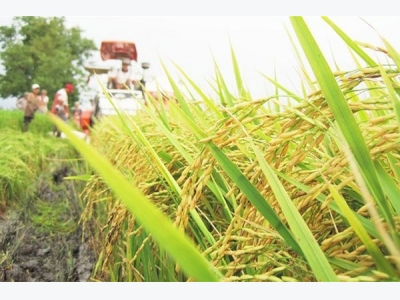Vietnam rice exporters should focus on Asian markets

Farmers are seen harvesting rice in a field in the Mekong Delta - PHOTO: TRUNG CHANH
CAN THO – Vietnam should put a special focus on traditional rice importers in Asia to ensure the country’s rice trade stability in the long run, said Huynh Minh Hue, secretary general of the Vietnam Food Association (VFA), at a conference in HCMC on October 17 on the rice export strategy for 2017-2020 period.
Asia is the nearest and most important market for Vietnamese rice, Hue said. In the first nine months of 2017, rice exports to Asian countries accounted for 68% of the country’s total.
Meanwhile, Africa is the second largest market for Vietnamese rice, with 15%, and should also be attended to, he said.
According to Hue, there have been concerns that Vietnam’s heavy reliance on the Chinese market, which accounted for 40% of the country’s rice exports, is risky. However, Hue downplayed such concerns, saying the neighboring country has high demand for rice in the long term.
Echoing the opinion, Do Ha Nam, general director of INTIMEX Group, said Vietnamese rice is shipped to hundreds of countries around the world, but most of it is purchased by Asian and African countries.
Particularly, China is a vital market.
Nam said the focus on strategic and regional markets would help rice exporters achieve stable export earnings.
Another important market for Vietnamese rice in Asia is the Philippines.
Hue said rice exports to the Philippines would grow further in the coming time if the Philippine Government agrees to shift its rice import from a quota-based mechanism to a tariff-based one.
He said the Philippines has plans to impose a 35% tariff on rice imports from ASEAN countries but 400% on rice from other countries, which will open the door wider for Vietnam as the country only has to compete with its only ASEAN rival Thailand.
Nam said Vietnam’s white rice is not competitive on the Chinese market because similar products from Pakistan and Myanmar have lower prices. However, Vietnam has exported large amounts of fragrant, glutinous and broken rice to China.
Meanwhile, the best-seller in Africa is jasmine rice, and in the Philippines it is white rice.
At the conference, Tran Xuan Long, head of the Agency of Foreign Trade under the Ministry of Industry and Trade, presented the strategy for rice export promotion in 2017-2020, with a vision towards 2030.
Vietnam will reduce the volume of rice exports but seek to raise the value, according to the strategy. The country looks to export 4.5-5 million tons of rice worth US$2.2-2.3 billion per year in 2017-2020, and four million tons worth US$2.3-2.5 billion per year in 2021-2030.
In 2020, white rice may account for 45% of total rice exports. Meanwhile, the proportions of fragrant rice, glutinous rice and rice products by then would be 30%, 20% and 5% respectively.
The country also expects to reduce reliance on the Asian market by lowering its rice export proportion to Asian countries from the current 68% to 60% in 2020 and 50% in 2030.
Trade ministry proposes Government amend circular on rice export
In a related development, the Ministry of Industry and Trade has sent the Government a draft decree on rice export, said Phan Van Chinh, head of the Import and Export Department under the ministry, at the conference on October 17.
Chinh told the Daily on the sidelines of the event that the draft decree would make life easier for rice exporters.
The prevailing Decree 109/2010/ND-CP requires rice traders to have at least one warehouse with a minimum capacity of 5,000 tons, and a milling facility with a minimum hourly processing capacity of 10 tons in order to get rice export certificates, he said.
He noted the draft decree still requires them to have warehouses and milling facilities in line with the standards set by the Ministry of Agriculture and Rural Development.
He said if rice exporters meet the requirements, they will only need to send their dossiers to the Ministry of Industry and Trade for approval.
He stressed the new regulation does not require them to have a prior confirmation from their local departments of industry and trade, adding that they must be accountable for their records. Upon the issuance of certificates, the ministry and local authorities will conduct checks later.
Exporters will store an amount of rice equivalent to 5% instead of the current 10% of the volume contracted for export, he said.
Notably, local firms will no longer be required to register their export contracts with the Vietnam Food Association (VFA) in advance for customs procedures.
Related news
 Vietnam targets US$2.5 billion in rice export revenues by 2030
Vietnam targets US$2.5 billion in rice export revenues by 2030 The Ministry of Industry and Trade (MOIT) has set the target of raising Vietnam’s rice export revenues to between US$2.3 and 2.5 billion by 2030.
 Dầu Tiếng Rubber Corporation invests in high-tech agriculture
Dầu Tiếng Rubber Corporation invests in high-tech agriculture Dầu Tiếng Rubber Corporation plans to build a high-tech agriculture zone, on an area of 2,000 hectares to improve efficiency in land use.
 Viet Nam rice industry should focus on quality: experts
Viet Nam rice industry should focus on quality: experts Vietnamese rice producers and exporters should focus on quality and supplying products that are in demand to sustain the production and export of the grain